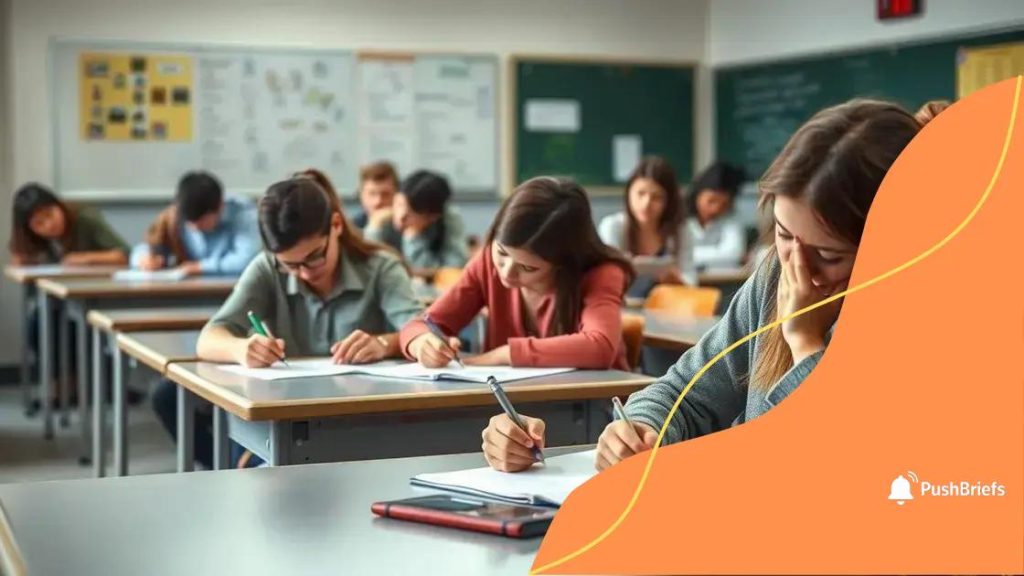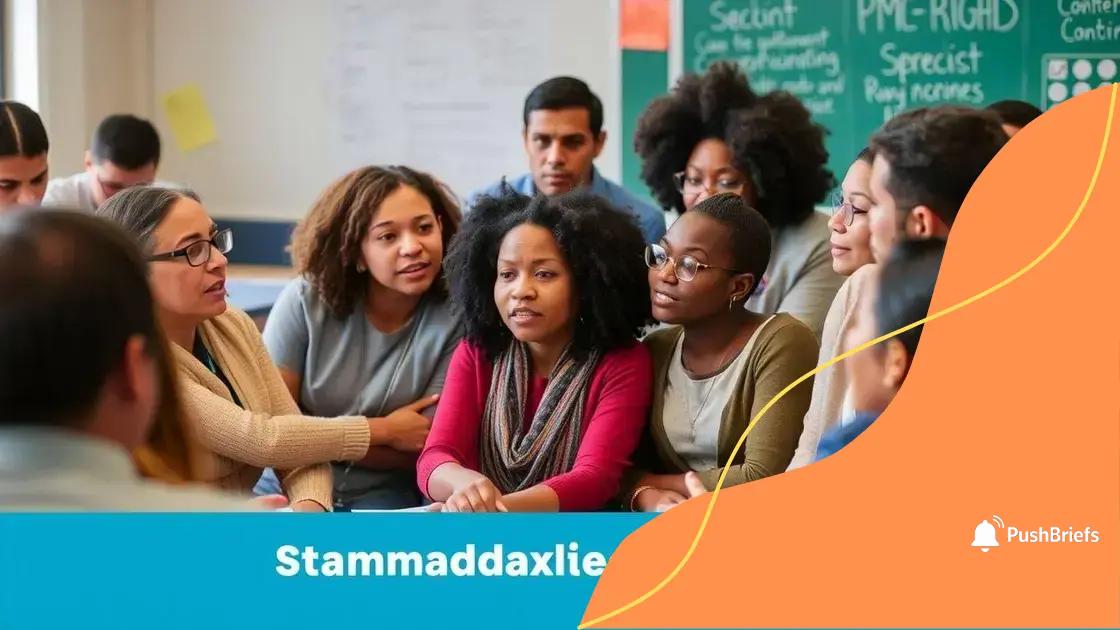The role of standardized tests is being re-examined: what’s next?

The role of standardized tests is being re-examined as they contribute to student stress, narrow the curriculum, and raise equity concerns, prompting educators to explore more holistic assessment alternatives.
The role of standardized tests is being re-examined as educators and policymakers question their effectiveness. What led to this shift? Are these assessments serving their intended purpose? Let’s dive into the nuances.
Understanding standardized tests
Understanding standardized tests is crucial for grasping their role in education. These exams have been part of school systems for many years. They often aim to measure student knowledge and performance.<\/p>
When we talk about standardized tests, it’s important to consider their purpose. These assessments often help in making key decisions about students’ futures. They can determine placement in advanced programs or be a requirement for graduation.
Types of standardized tests
There are different types of standardized tests used in schools. Each serves a unique purpose, making it essential to understand them fully.
- Achievement Tests: Measure what students have learned in specific subjects.
- Aptitude Tests: Evaluate a student’s potential to succeed in future schooling or training.
- Diagnostic Tests: Identify students’ strengths and weaknesses in particular areas.
Each of these tests plays a pivotal role in education. However, critics argue about their effectiveness in truly measuring a student’s abilities. For instance, some feel that they promote stress and a narrow focus on test-taking skills rather than holistic learning.
Importance of understanding limitations
Recognizing the limitations of standardized tests is vital. These assessments can sometimes fail to represent a student’s full capabilities. Many argue that they do not account for diverse learning styles or backgrounds.
Furthermore, relying solely on these tests can lead to unfair consequences for many students. Understanding this helps teachers and parents advocate for more comprehensive evaluation methods.
By exploring the reasons behind standardization and its impact on student learning, we can better engage in discussions about educational reform and innovation.
Historical context of standardized testing
The historical context of standardized testing reveals its evolution over time. Originally, these tests were designed to assess student knowledge in a uniform way. The first major standardized tests began in the early 20th century, aiming to create a fair method of evaluating students across various backgrounds.
As education systems expanded, standardized tests became more common. They were introduced as a response to the increasing need for accountability in schools. This led to the establishment of national norms that schools could use to compare student performance.
Key milestones in testing history
Significant events shaped the development of standardized tests. Some of these milestones include:
- 1905: The first Stanford-Binet Intelligence Test was created, focusing on assessing intelligence.
- 1965: The Elementary and Secondary Education Act (ESEA) pushed for equal educational opportunities, leading to the rise of standardized assessments.
- 2001: The No Child Left Behind Act mandated standardized testing as a way to measure school performance.
These milestones highlight how testing evolved with the changing needs of education. Over time, they have sparked discussions about fairness and effectiveness, particularly regarding minority and low-income students.
The impact of historical events
Understanding the impact of historical events is crucial. For instance, wars and social movements influenced educational policies and testing practices. During the civil rights movement, there was heightened awareness of educational disparities. This awareness raised questions about the appropriateness of standardized tests for all students.
Many educators began to challenge the idea that a single test could measure the abilities of every student. This ongoing debate has led to a reevaluation of how we assess learners in today’s diverse classrooms.
Current debates surrounding testing

Current debates surrounding standardized testing are intense and multifaceted. Many educators, parents, and policymakers question the effectiveness of these assessments. While some believe they are essential for measuring student progress, others argue they create more problems than they solve.
One major concern is whether these tests truly reflect a student’s abilities and potential. Critics argue that standardized tests often favor students from more affluent backgrounds, leaving those from disadvantaged circumstances at a disadvantage. This raises critical questions about equity in education.
Key issues in the debate
Several key issues fuel the debate over standardized testing today:
- Stress for Students: Many students experience significant stress and anxiety due to the pressure of performing well on these exams.
- Teaching to the Test: Some educators adapt their teaching methods solely to improve test scores, which can undermine broader learning objectives.
- Assessment Validity: Questions have arisen regarding whether standardized tests accurately measure a student’s knowledge and skills.
Many educators advocate for more holistic assessment methods that take various aspects of a student’s learning into account. These methods include project-based assessments and portfolio reviews, which can provide a more comprehensive view of a student’s capabilities.
Voices of dissent
In addition to parents and teachers, a variety of organizations are speaking out against the reliance on standardized tests. Education reform advocates argue for a shift toward more inclusive and equitable assessment practices. They emphasize the need for tests that are designed to be fair to all students, regardless of their background.
As these debates continue, many stakeholders are seeking a balance between accountability and the well-being of students. Understanding different perspectives can help create a more equitable educational system.
Alternatives to standardized tests
Alternatives to standardized tests are gaining attention as educators seek better ways to assess student learning. These methods offer a more comprehensive view of a student’s abilities and knowledge.
One popular alternative is performance-based assessment. This approach involves students completing tasks that demonstrate their understanding. For example, instead of taking a multiple-choice exam, students might work on a project or presentation. This method allows teachers to see how well students apply their knowledge in real-world situations.
Types of alternative assessments
There are several types of alternative assessments that schools can consider:
- Project-based learning: Students engage in projects that require critical thinking and problem-solving.
- Portfolio assessments: A collection of a student’s work over time showcases their learning journey and growth.
- Formative assessments: These are ongoing assessments that provide feedback throughout the learning process.
Using these assessments allows teachers to tailor their instruction to meet student needs. For instance, performance-based assessments can reveal specific skills students excel or struggle with. In this way, educators can adapt their teaching strategies accordingly.
Benefits of alternative assessments
There are many benefits to using alternatives to standardized tests. One significant advantage is the emphasis on critical thinking. Traditional tests often focus on memorization, while alternatives encourage students to think deeply and creatively.
Additionally, alternative assessments can be more engaging for students. When students participate in hands-on activities or creative projects, they are often more motivated and invested in their learning. This can lead to a positive classroom environment where students feel valued and understood.
Learning should be about more than just test scores. By considering alternatives to standardized assessments, educators can create a more inclusive and fair measurement of student achievement.
Impact on students and education
The impact on students and education of standardized testing can be profound. These tests can shape the educational experience and influence students’ futures in significant ways.
When standardized tests are emphasized, students often feel increased pressure to perform. This pressure can lead to anxiety and stress, affecting their overall well-being. Many students may worry about not meeting expectations, which can disrupt their learning experience.
Effects on student learning
Standardized tests influence how teachers deliver instruction. Because teaching may become focused on test preparation, creativity and exploration can suffer. Students might miss out on opportunities to engage deeply with subjects, as the curriculum narrows to include only test-relevant material.
- Test Anxiety: Some students develop anxiety around test-taking, which can hinder performance.
- Narrowed Curriculum: A focus on standardized tests can limit exposure to a broader education.
- Equity Issues: Students from different backgrounds may not have equal access to resources for test preparation.
It is important to recognize that the emphasis on standardized testing can create disparities in educational opportunities. For example, students from lower-income families may not have access to tutoring or preparatory resources. This can lead to performance gaps that undermine the fairness of the assessment system.
Long-term consequences
The long-term consequences of relying heavily on standardized tests can affect students’ futures. Students who perform poorly may face limited opportunities for advanced programs or college admissions. This pressure can discourage learners from pursuing their interests or talents.
Many experts argue for broader measures of success that include social and emotional learning. By considering multiple facets of student development, educators can better support student growth beyond mere test scores. The aim is to create a more holistic educational environment that addresses the needs of all learners.
FAQ – Frequently Asked Questions about Standardized Testing in Education
What are standardized tests used for?
Standardized tests are designed to measure students’ knowledge and skills in specific subjects, helping schools evaluate performance.
How do standardized tests affect student stress?
Many students experience anxiety related to standardized tests, which can impact their performance and overall learning experience.
What alternatives exist to standardized testing?
Alternatives include performance-based assessments, project-based learning, and portfolio assessments that provide a more comprehensive view of a student’s abilities.
Why is equity important in education assessments?
Equity ensures that all students, regardless of background, have equal opportunities to succeed and receive fair evaluations of their abilities.
